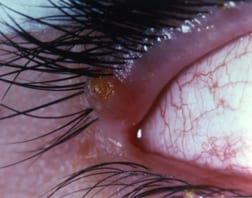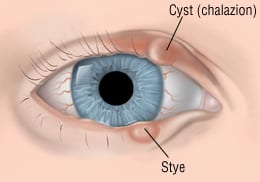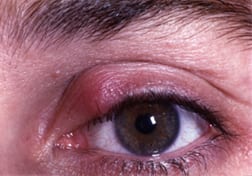Patient Basics: Styes And Chalazions
Originally published by Harvard Health.
What Is It?
A sty, also called hordeolum, is a small abscess of the oil gland associated with an eyelash hair follicle. It typically contains Staphylococcus aureus bacteria, the cause of staph infections. When a sty develops, a small area of the upper or lower eyelid or the corner of the eye becomes red, tender and swollen. Swelling subsides gradually over a period of days after the sty develops an opening, and the pus is able to drain out.
A chalazion, like a sty, is a swelling within the eyelid caused by inflammation of an oil gland. A chalazion differs from a sty in that it does not contain an active bacterial infection. A chalazion is sometimes the aftereffect of a sty. It is less tender but lasts longer.
Natural oils from the eyelid’s oil glands must drain through ducts out to the eyelashes. If debris blocks this normal drainage, it may cause a sty or chalazion. Sometimes, this debris accumulates because of a condition called blepharitis, a long-standing inflammation of the edges of the eyelids, with redness, thickening and scales and crusts.
Symptoms
A sty or chalazion begins as a tender red lump or bump within the eyelid at the base of the eyelash. It may cause tearing, light sensitivity and the sensation of having something in the eye. Swelling usually involves only a small area of the lid, but in some cases it can lead to irritation and redness of the whole eyelid. A small, yellowish spot eventually appears in the center of a sty, when the pus collection expands to become visible just beneath the skin or eyelid surface. Pain usually is relieved when the sty ruptures, draining the pus through an opening in the skin, the lid margin or the undersurface of the lid.
A chalazion at first may be red and swollen for a few days, but eventually it changes to a painless, slowly growing, round mass in the lid. The skin around this firm rubbery lump can be moved loosely over the swelling.
Diagnosis
You or your doctor can diagnose a sty or chalazion by looking at it. Both styes and chalazions usually go away on their own without medical attention.
Expected Duration
A sty usually goes away in a week or two. Chalazions generally take longer, disappearing after a month or more. Warm compresses can help both styes and chalazions go away sooner.
Prevention
Good hygiene is the best way to prevent styes and chalazions. Keep your hands clean, don’t rub your eyes, and don’t share eye makeup. This is particularly important for people who have had styes or chalazions more than once.
Treatment
Warm compresses can help styes and chalazions heal faster. Moisten a clean, folded washcloth with warm water and hold it gently against the eye for 5 minutes several times a day for several days. The moist washcloth can be heated in a microwave over. This will encourage a sty or chalazion to open a drainage channel, allowing any pus to drain away and restoring normal drainage from oil glands. Change the washcloth frequently, particularly as a sty drains.
Pus should never be removed by squeezing. A sty that fails to drain can be lanced (opened) by a doctor.
If you are prone to recurring styes, your doctor may prescribe antibiotics. He or she may treat a chalazion with corticosteroid drops to control inflammation. If a chalazion does not go away on its own after six weeks, it may need to be removed surgically under local anesthesia.
When To Call a Professional
Seek medical attention if a lump or bump on the eyelid impairs vision, or if it does not go away on its own after several days of treatment with warm compresses. Very rarely, a tumor of the eyelid can look like a chalazion. If redness spreads to the entire lid, you should arrange for prompt examination by a doctor.
Prognosis
A sty resolves within a week after the pus drains. A chalazion takes longer, sometimes months, to heal. Neither damages the eye.
Additional Info
American Academy of Ophthalmology
P.O. Box 7424
San Francisco, CA 94120-7424
Phone: 415-561-8500
Fax: 415-561-8533
http://www.aao.org/news/eyenet/



